The other day there was a Skink in my kitchen.
Skinks do not belong in the kitchen.
Yes, I admit that my house is disorganized with entirely too much stuff, but I have never described my mess as “Everything including the kitchen Skink“.
Well, I spent a few nights worrying like an overprotective skink-mother. Why were you worried? Because there are two dogs in the house and one of them (I won’t tell you that his name is Jack) tries to eat lizards even when they taste nasty. Eeeww!
The next day Jack and I were walking around in the yard. He likes to jump up onto the deck. Okay, the truth is that he is too short to make the leap; I actually have to lift him up there, but let’s keep his dignity intact and say he jumps up all by himself. He noses around for a minute or two hoping for a tasty morsel. Wood roaches are tasty. Then he makes a mad leap and dives headfirst into a 5-gallon plastic bucket. Whoa!!! It could be anything – a snake, a spider, an inch of water he could drown in. Doesn’t Jack read the warning on the side of the bucket?
No, Jack no. Please, just let me have a little look first.
Well, would you look at that!
Here, look for yourself –
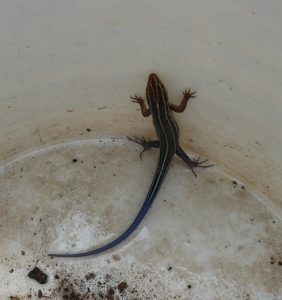
Let me get in a little closer – here you go –
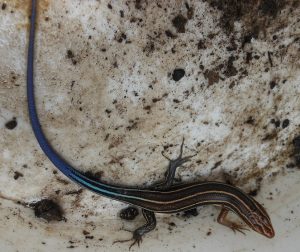
Isn’t that just the cutest Skink in the whole world. It’s kind of dark in the bucket; we need a closer look, please.
C’mon into the light Skink, show us your pretty blue tail… 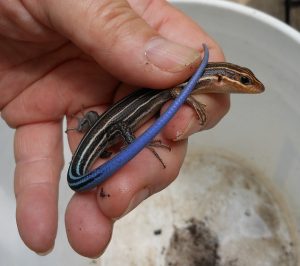
Fun time is over. The Skink is developing an attitude and it’s time to turn it loose.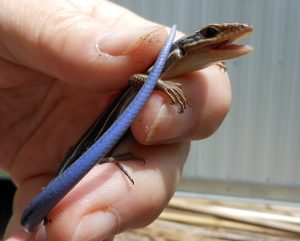
If there is a lesson to learn it is this:
If a Skink can find its way into your kitchen, it must also know how to let himself out so don’t lose any sleep worrying about it. Also, if you keep plastic buckets around to catch rainwater, check them not only for mosquitoes but for Skinks as well. Maybe you should write a tutorial showing how to make screen lids for 5-gallon buckets?
For more information about lizards with blue tails, check this link for Hilton Pond:
http://www.hiltonpond.org/ThisWeek071001.html
Eumeces fasciatus = Five-lined Skink
E. inexpectatus = Southeastern Five-lined Skink
Taxonomists are forever changing the name of things. Here is the Catalog of Life page for the Five-lined Skink with the currently accepted name Plestiodon fasciatus. Who knows? By the time you read this, the name could change again!
http://www.catalogueoflife.org/col/details/species/id/7083c8e865d1e893839b07e3fa809dce
Plestiodon laticeips = Broadhead/Broad-Head Skink. Hmmm, apparently, using the V-shape marking on the head is not the proper way to identify a Skink. There are three types of Skink residing in my part of the world and when they are young, they can look alike, having stripes and a bright blue tail. A better way is to count the labial scales – I see 5 scales so I think that my Skink is an immature Broadhead Skink. 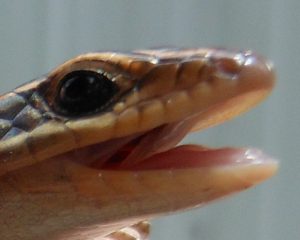
This link shows where the labial scales are located: